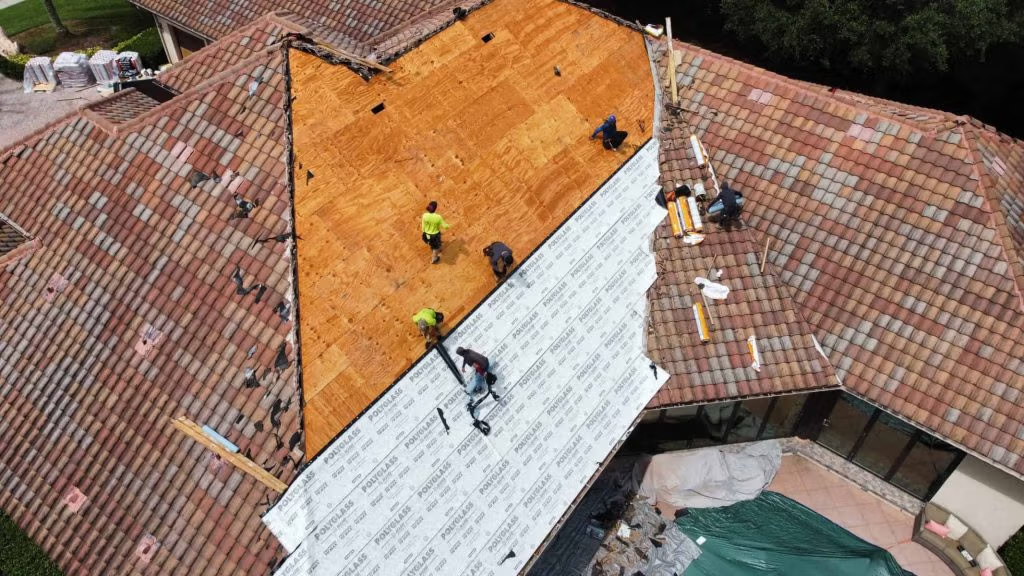Storms are a common occurrence in Central Florida, and they can wreak havoc on your home’s roof. At Gravity Roofing, we understand the urgency and importance of addressing roof damage promptly to protect your home and family. This comprehensive emergency roof repair guide will walk you through the steps to take when your roof is damaged by a storm, ensuring your safety and minimizing further damage.
Keeping You Safe First
Ensure Your Safety:
- Use Proper Equipment: Safety should always be your top priority when dealing with roof damage. Equip yourself with sturdy shoes with good traction to prevent slips, a helmet for head protection, and gloves to protect your hands from sharp objects. Using a safety harness can also provide added security, especially if you need to climb onto the roof for an emergency roof repair. For more detailed safety guidelines, refer to the Occupational Safety and Health Administration (OSHA) website.
- Choose the Right Time: It’s crucial to wait until the storm has completely passed and the weather is clear before attempting any inspection or emergency roof repair. Wet or windy conditions can make your roof slippery and dangerous. Choose a time when the weather is stable, and there’s plenty of daylight to see clearly.
- Buddy Up: Never attempt to inspect or repair your roof alone. Having someone with you can provide immediate assistance if an accident occurs. Your buddy can also help you with tools and provide an extra set of eyes to spot potential hazards during the emergency roof repair process.
Assess the Situation for Your Safety:
- Stay Informed: Keep an eye on weather updates and local news to understand the storm’s impact and ongoing weather conditions. This information can help you assess whether it’s safe to go outside and begin emergency roof repair.
- Inspect Your Home: Before heading to the roof, inspect your home’s interior for signs of leaks or structural damage. Look for water stains on ceilings and walls, and check for any unusual smells that could indicate mold or mildew.
- Check for Downed Power Lines: Avoid any fallen power lines or exposed wires around your property. These can be extremely dangerous, so keep a safe distance and contact your local utility company to handle them.
Additional Safety Measures:
- Avoid Severely Damaged Areas: If you suspect that your roof is severely compromised, avoid those areas to prevent any risk to your structural integrity or personal safety. Use binoculars to inspect from a safe distance if necessary during your emergency roof repair assessment.
Assessing Your Roof’s Damage
Exterior Inspection for Your Roof:
- Missing or Damaged Shingles: Walk around your home and visually inspect the roof for missing, cracked, or torn shingles. These vulnerabilities can allow water to seep into your home, leading to further damage and necessitating emergency roof repair.
- Dented or Bent Flashing: Check the flashing around roof penetrations like chimneys, vents, and skylights. Damaged flashing can lead to leaks and should be repaired promptly to maintain the roof’s integrity.
- Loose or Damaged Gutters: Inspect your gutters for any signs of damage or debris buildup. Loose or damaged gutters can cause water to overflow, potentially damaging your home’s foundation and landscaping.
Interior Inspection for Your Roof:
- Water Stains: Inside your attic or crawl space, look for water stains on the ceiling and walls. These stains can indicate leaks that need immediate attention and emergency roof repair.
- Damp or Musty Odors: Smell the air in your attic or crawl space for any musty odors, which can be a sign of moisture buildup and potential mold growth.
- Visible Light: During the day, turn off the lights in your attic and look for any spots where daylight is coming through. These gaps can allow water and pests to enter and should be sealed as part of your emergency roof repair.
Documenting Your Roof’s Damage
- Photograph Everything: Take clear photos or videos of all visible damage, both inside and outside your home. These will be crucial when filing insurance claims after your emergency roof repair.
- Make a List of Damaged Items and Areas: Create a detailed inventory of all the damaged areas and items, including the roof, ceilings, walls, and personal belongings. This list will help you communicate the extent of the damage to your insurance adjuster.
- Record Temporary Repairs: Document any temporary repairs you make to prevent further damage, as this can support your insurance claim.
Making Temporary Repairs
Tarp Up Your Roof:
- Use Tarps: Cover damaged areas with heavy-duty tarps to prevent further water infiltration. Secure the tarps with nails or weighted objects to ensure they stay in place during subsequent weather events.
- Address Leaks: Place buckets or containers under any leaks inside your home to catch dripping water and prevent it from spreading further during the emergency roof repair process.
Secure Your Loose Shingles:
- Inspect and Replace Missing Shingles: If you notice any shingles missing, replace them promptly to prevent further damage. You can purchase replacement shingles from your local home improvement store.
- Use Roofing Cement or Nails: For loose shingles that are still intact, use roofing cement or nails to secure them back in place. Ensure the edges and corners are well-sealed to prevent water infiltration during your emergency roof repair.
Prevent Further Damage:
- Use Heavy-Duty Materials: Make sure to use materials that can withstand wind and rain when performing temporary repairs as part of your emergency roof repair.
Getting Professional Help for Your Roof
Contact Your Insurance: File a Claim
- Provide Documentation: Share the photos, videos, and detailed list of damage with your insurance adjuster to support your claim for emergency roof repair.
- Follow Procedures: Adhere to your insurer’s guidelines for filing a claim, providing necessary information, and obtaining approval for emergency roof repair.
Get Professional Quotes: Obtain estimates from roofing professionals
- Obtain Multiple Quotes: Contact several reputable roofing contractors to get quotes for the repairs. This ensures you receive a fair price and quality service.
- Hire a Reputable Roofer: Verify credentials, avoid storm chasers.
- Check Credentials: Verify the contractor’s license, insurance, and references. Avoid contractors who go door-to-door offering services, as they may not be reliable.
- Avoid Pressure Sales: Be cautious of high-pressure sales tactics. Take your time to make an informed decision and choose a contractor you trust for your emergency roof repair.
Call a Professional Roofer:
- Licensed and Experienced Contractors: Emergency roof repairs should always be handled by a professional. Contact a licensed and experienced roofing contractor who specializes in emergency roof repair. They can assess the damage, provide an accurate estimate, and carry out the necessary repairs safely and efficiently.
DIY vs. Professional Repairs for Your Roof
DIY Repairs:
- Handling Minor Repairs: If you’re experienced with roofing work, you might handle minor repairs like securing loose shingles or applying roofing cement.
- Safety Precautions: Always prioritize safety. Use the proper equipment and follow best practices to avoid accidents during emergency roof repair.
Professional Assistance:
- When to Seek Help: For significant damage or if you’re unsure about the repair process, it’s best to hire a professional. They have the expertise and equipment to handle complex repairs safely.
- Importance of Experienced Contractors: Experienced contractors can assess the damage accurately and provide long-lasting repairs, ensuring your roof remains secure after an emergency roof repair.
Preventive Measures for Your Roof
Future Prevention:
- Regular Inspections: Schedule regular roof inspections to catch potential issues early and prevent them from becoming major problems that require emergency roof repair.
- Clean Gutters and Downspouts: Keep your gutters and downspouts clear of debris to ensure proper water drainage and prevent overflow.
- Trim Overhanging Branches: Trim any branches that overhang your roof to reduce the risk of damage from falling limbs during storms.
Reinforce Your Roofing:
- Invest in Impact-Resistant Materials: Consider upgrading to impact-resistant shingles or roofing materials designed to withstand severe weather.
- Install Storm Straps: Install hurricane straps to secure your roof to your home’s structure, providing additional protection during storms.
Understanding Your Insurance Procedures
- Understand Your Coverage: Review your insurance policy to understand what types of storm damage are covered and what your deductible is for emergency roof repair.
- Review Policy Limits: Ensure your coverage limits are sufficient to cover potential storm damage expenses.
- Follow Insurer’s Guidelines: Follow your insurer’s procedures for filing claims and providing necessary documentation to ensure a smooth process for emergency roof repair.
Preparing for Disasters
Weather Alerts:
- Use Weather Apps: Download weather apps or sign up for alerts to receive timely warnings about approaching storms.
- Emergency Plan: Create an emergency plan for your family, including evacuation routes and a safe meeting place.
Disaster Kit:
- Basic Supplies: Keep a disaster kit with essentials like water, non-perishable food, flashlights, batteries, and a first-aid kit.
- Important Documents: Store copies of important documents, such as insurance policies, in a waterproof container.
Conclusion
Being prepared for storm damage can significantly reduce the impact on your home and ensure your family’s safety. By following this comprehensive guide, you can handle emergency roof repair efficiently and effectively. Remember, Gravity Roofing is here to help Central Florida residents with all their roofing needs. Don’t hesitate to reach out to us for professional assistance and reliable service. Stay safe and prepared!














